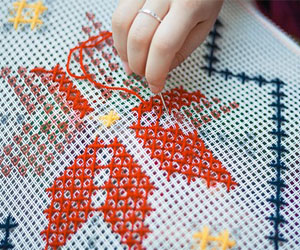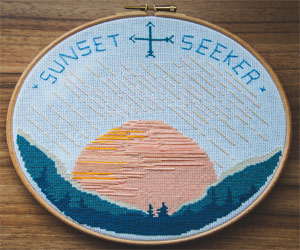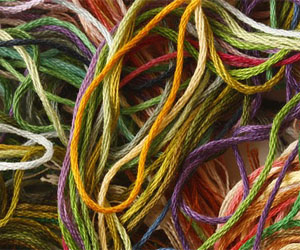


Crafting Your Way To Creativity And Fulfillment

Handmade projects, often crafted with love, dedication, and a touch of creativity, have been a cherished part of human culture for centuries. Whether it's knitting a cozy scarf, woodworking to create beautiful furniture, or stitching together a quilt, handmade projects provide a fulfilling and rewarding experience that goes beyond the end product. In this article, we'll delve into the world of handmade projects and explore the reasons why they continue to be a source of joy and inspiration.
Personalization: One of the most remarkable aspects of handmade projects is the opportunity for personalization. When you create something by hand, you have full control over the design, color, materials, and size. This level of customization allows you to craft items that perfectly suit your needs or the preferences of those you're creating for.
Creativity: Handmade projects are a canvas for your imagination. Whether you're crafting jewelry, painting, or experimenting with woodworking, each project is a chance to explore your creative potential. This creative expression can be incredibly fulfilling and lead to personal growth.
Unique Gifts: Handmade gifts are often cherished by both the creator and the recipient. They carry a unique and personal touch that can't be replicated by mass-produced items. Whether it's a hand-knitted sweater or a hand-painted portrait, these gifts are a symbol of love and thoughtfulness.
Mental Well-Being: Engaging in a handmade project can be therapeutic and calming. The focus required for crafting helps alleviate stress and promotes mindfulness. It's a form of active meditation that allows you to escape from the demands of daily life and achieve a sense of peace.
Skill Development: Handmade projects offer the opportunity to learn and develop new skills. Whether you're perfecting your knitting techniques, honing your woodworking abilities, or expanding your artistic talents, each project is a chance for growth and self-improvement.
Sustainability: In an age of mass production and consumerism, handmade projects can be a sustainable choice. Crafting your own items reduces the need for disposable products and promotes a culture of reuse and sustainability.
Connection: Handmade projects often bring people together. Joining crafting communities, attending workshops, or collaborating on projects with friends or family can foster a sense of connection and shared creativity.
To get started with your own handmade projects, consider the following:
Choose Your Craft: Select a craft that interests you the most. Whether it's sewing, pottery, knitting, or any other craft, your passion will drive your creativity.
Gather Materials: Acquire the necessary materials and tools. Invest in quality materials to ensure a successful and rewarding crafting experience.
Start Simple: Begin with straightforward projects to build your confidence and skills. As you gain experience, you can take on more complex and intricate creations.
Learn From Others: Join crafting groups, attend classes, or watch online tutorials. Learning from experienced crafters can provide valuable insights and techniques.
Enjoy The Journey: Embrace the process and savor each moment of your crafting journey. The end product is important, but the joy of creation lies in the steps you take to get there.
Handmade projects offer an opportunity for personalization, creativity, and connection, while also promoting mental well-being, skill development, and sustainability. Whether you're a seasoned crafter or a beginner, embarking on handmade projects can lead to a fulfilling and rewarding journey of creativity and self-discovery. So, pick up your tools, unleash your creativity, and let your handmade projects be a source of joy and inspiration in your life.
Exploring The World Of Embroidery Stitches
 French Knot: A highly decorative stitch that creates raised, textured dots. These knots can be used for flowers, eyes, or other small, ornamental details.
French Knot: A highly decorative stitch that creates raised, textured dots. These knots can be used for flowers, eyes, or other small, ornamental details.
Chain Stitch: A looping stitch that forms a chain-like line. It's versatile and can be used for both lines and filling areas, creating a textured, rope-like appearance.
Feather Stitch: This stitch resembles the delicate fronds of a feather, with stitches on either side of a central line. It is often used to depict leaves, vines, or other organic elements.
Bullion Knot: A stitch that creates a raised, coiled effect. It's perfect for floral and three-dimensional embroidery work, adding depth and dimension.
Embroidery In Culture And Tradition: Regional Stitches
Different cultures around the world have their unique embroidery stitches and styles, often reflecting the traditions, values, and artistic sensibilities of their communities.
Sashiko (Japan): Known for its geometric, repetitive patterns, sashiko uses running stitches to create designs that are both decorative and functional. It's often used for mending and reinforcing fabric.
Crewelwork (England): This traditional embroidery style employs wool threads and intricate stitches to create detailed designs, often depicting pastoral scenes and floral motifs.


Illuminating The Profound Meanings
 Light And Hope: Candles are often seen as symbols of light piercing through darkness, representing hope and the triumph of good over evil. Lighting a candle can be an act of optimism, a way to banish the shadows, and a beacon of hope during challenging times.
Light And Hope: Candles are often seen as symbols of light piercing through darkness, representing hope and the triumph of good over evil. Lighting a candle can be an act of optimism, a way to banish the shadows, and a beacon of hope during challenging times.
Spirituality And Religion: Candles hold significant importance in many religious and spiritual practices. In Christianity, the lighting of candles in churches signifies Christ as the "light of the world." In Buddhism, candles are lit to symbolize the enlightenment of Buddha, while in Hinduism, they are used during various ceremonies to represent the divine presence.
Memorial And Remembrance: Candles are a powerful symbol of remembrance and reverence. Lighting a candle in memory of a loved one who has passed away is a common practice. It symbolizes that the memory of that person continues to shine in our hearts.
Celebration And Joy: Candles are used during celebrations to symbolize joy and festivity. Birthday candles, for example, signify the joy of another year of life. In many cultures, candles are an essential part of wedding ceremonies, representing the joy and union of the couple.
The Magical Transformation Behind The Brew
 The Fermentation Process: Fermentation begins when the wort (unfermented beer) is transferred to a fermentation vessel, and yeast is introduced. The yeast starts consuming the sugars, breaking them down into alcohol, carbon dioxide, and a range of flavor compounds. During this process, the temperature and oxygen levels are carefully controlled to achieve the desired characteristics for the beer style.
The Fermentation Process: Fermentation begins when the wort (unfermented beer) is transferred to a fermentation vessel, and yeast is introduced. The yeast starts consuming the sugars, breaking them down into alcohol, carbon dioxide, and a range of flavor compounds. During this process, the temperature and oxygen levels are carefully controlled to achieve the desired characteristics for the beer style.
Primary And Secondary Fermentation: The initial fermentation, called primary fermentation, typically lasts one to two weeks. Afterward, some beer styles may undergo a secondary fermentation or conditioning phase. In secondary fermentation, the beer may be transferred to a different vessel, such as a secondary fermenter or barrels, to develop further flavors and clarity.
Flavor Development: The fermentation process is where the beer's flavor is largely determined. Yeast produces a wide variety of compounds, including alcohols, esters, and phenols, which contribute to the aroma and taste of the beer. For example, esters can impart fruity notes like banana or apple, while phenols may introduce subtle smoky or spicy characteristics.
Alcohol Production: The yeast's primary job is to convert sugars into alcohol. Ethanol, the type of alcohol found in beer, is the result of this process. The level of alcohol in the final beer depends on factors such as the type and amount of malt used and the yeast's alcohol tolerance.
Carbonation: In addition to alcohol, fermentation produces carbon dioxide, which is the source of beer's effervescence. The carbonation level can be controlled by varying factors like yeast strain, fermentation temperature, and pressure during packaging. Some beer styles are naturally carbonated, while others may undergo forced carbonation.
Achieving Consistency: Consistency in fermentation is crucial for breweries to produce the same beer batch after batch. Modern breweries employ precise temperature control and automated equipment to maintain the ideal fermentation conditions, ensuring that the beer's flavor and alcohol content remain consistent.
Crafting Your Way To Inner Peace
 Handmade serenity is a form of active meditation. As you immerse yourself in your craft, you enter a state of flow, where time seems to stand still, and you're completely absorbed in the process. This meditative quality of crafting can be profoundly calming and is akin to mindfulness meditation, a practice proven to reduce anxiety and promote mental and emotional well-being.
Handmade serenity is a form of active meditation. As you immerse yourself in your craft, you enter a state of flow, where time seems to stand still, and you're completely absorbed in the process. This meditative quality of crafting can be profoundly calming and is akin to mindfulness meditation, a practice proven to reduce anxiety and promote mental and emotional well-being.
The tactile nature of handmade creations has a soothing effect on your senses. Feeling the textures, seeing the colors, and manipulating the materials can be a sensory experience that grounds you in the moment. Whether you're kneading dough for homemade bread, shaping clay into pottery, or sewing fabric into a quilt, your senses come alive, enhancing your connection to the world around you.
Moreover, handmade serenity is about the sense of accomplishment that comes with completing a project. Seeing your creations come to life can be incredibly rewarding, instilling a sense of pride and purpose. It's a tangible representation of your creativity and effort, and this feeling of achievement can boost your self-esteem and sense of self-worth.
Crafting also allows you to take control of your surroundings. You can make your home more inviting and cozy with handmade decor, such as quilts, paintings, or handcrafted furniture. These pieces carry a personal touch that can transform your living space into a sanctuary of serenity, providing a refuge from the chaos of the outside world.
A Timeless Connection
 The Romans, too, played a pivotal role in the history of wine. They expanded vine cultivation across their vast empire, introducing new techniques in viticulture and winemaking. The famous phrase "in vino veritas" (in wine, there is truth) emerged from Roman culture, emphasizing the way wine could loosen tongues and reveal one's innermost thoughts.
The Romans, too, played a pivotal role in the history of wine. They expanded vine cultivation across their vast empire, introducing new techniques in viticulture and winemaking. The famous phrase "in vino veritas" (in wine, there is truth) emerged from Roman culture, emphasizing the way wine could loosen tongues and reveal one's innermost thoughts.
Medieval Monasteries: Throughout the Middle Ages, wine remained a significant part of European culture. Monasteries became centers of wine production and preservation. Monks carefully cultivated vineyards and perfected the art of winemaking, leading to the creation of some of the world's most renowned wine regions, such as Bordeaux and Burgundy.
Exploration And Trade: As European explorers set out to conquer new lands, they brought vines with them to cultivate wine in their new colonies. Wine became a valuable trade commodity, driving exploration and colonization. Spanish missionaries, for instance, planted vineyards in California, paving the way for the Napa Valley wine region.
Modern Times: In more recent history, the 19th and 20th centuries witnessed significant advancements in winemaking techniques and the establishment of regulations governing the production of wine. Winemakers like Louis Pasteur made groundbreaking contributions to the science of fermentation, ensuring the consistent quality of wine.
The Path To Healthier, Radiant Skin And Self-Confidence
 Understanding The Toxins: Non-toxic beauty advocates for the avoidance of harmful chemicals commonly found in many conventional beauty products. These chemicals, such as parabens, phthalates, formaldehyde, and artificial fragrances, have been associated with various health concerns, including allergies, hormonal disruption, and even cancer.
Understanding The Toxins: Non-toxic beauty advocates for the avoidance of harmful chemicals commonly found in many conventional beauty products. These chemicals, such as parabens, phthalates, formaldehyde, and artificial fragrances, have been associated with various health concerns, including allergies, hormonal disruption, and even cancer.
Clean Ingredients: Non-toxic beauty products are formulated with clean, safe ingredients. This means they exclude harmful chemicals and replace them with natural, organic, and plant-based alternatives. For example, clean skincare often uses ingredients like aloe vera, shea butter, and essential oils.
Sustainability Matters: Non-toxic beauty goes hand in hand with sustainability. Brands that champion non-toxic beauty often focus on eco-friendly packaging and sustainable sourcing of ingredients. By reducing their environmental footprint, they align with the principles of environmental consciousness.
Transparency And Accountability: Non-toxic beauty brands are known for their transparency. They provide clear information about the ingredients they use, their sourcing, and their production processes. This empowers consumers to make informed choices about the products they apply to their skin.
Cruelty-Free: Many non-toxic beauty brands are committed to cruelty-free practices. They don't test their products on animals, aligning with the values of ethical consumerism.
Non-Toxic Makeup: Non-toxic beauty extends beyond skincare to include makeup products. Non-toxic makeup brands provide a range of clean cosmetics, from foundation and lipstick to mascara and eyeshadow, offering a safer alternative for enhancing beauty.
A Sustainable Lifestyle For A Better Future
 Reduce, Reuse, Recycle: This timeless mantra forms the foundation of green living. Reducing consumption, reusing items when possible, and recycling materials are essential steps in minimizing waste.
Reduce, Reuse, Recycle: This timeless mantra forms the foundation of green living. Reducing consumption, reusing items when possible, and recycling materials are essential steps in minimizing waste.
Energy Efficiency: Green living encourages energy-conscious choices such as using energy-efficient appliances, properly insulating homes, and turning off lights and electronics when not in use.
Sustainable Transportation: Opting for eco-friendly modes of transportation, such as biking, walking, carpooling, or using public transit, reduces carbon emissions associated with personal vehicles.
Sustainable Food Choices: Adopting a diet rich in locally sourced, organic, and plant-based foods can reduce the carbon footprint associated with food production and distribution.
Water Conservation: Conserving water through practices like fixing leaks, using low-flow fixtures, and reducing water waste is a fundamental aspect of green living.
Minimalism: Embracing minimalism involves living with fewer possessions, which not only reduces consumption but also fosters a simpler, more sustainable lifestyle.
Benefits Of Green Living
Reduced Environmental Impact: Green living minimizes resource consumption, lowers carbon emissions, and reduces waste, thus mitigating harm to the environment.
Cost Savings: Energy-efficient practices, reduced consumption, and sustainable choices often lead to financial savings over time.